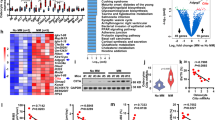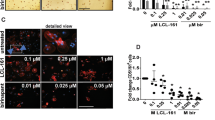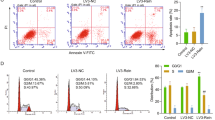Abstract
Upregulation of cytokines and chemokines is a frequent finding in multiple myeloma (MM). CCL3 (also known as MIP-1α) is a pro-inflammatory chemokine, levels of which in the MM microenvironment correlate with osteolytic lesions and tumor burden. CCL3 and its receptors, CCR1 and CCR5, contribute to the development of bone disease in MM by supporting tumor growth and regulating osteoclast (OC) differentiation. In this study, we identify inhibition of osteoblast (OB) function as an additional pathogenic mechanism in CCL3-induced bone disease. MM-derived and exogenous CCL3 represses mineralization and osteocalcin production by primary human bone marrow stromal cells and HS27A cells. Our results suggest that CCL3 effects on OBs are mediated by ERK activation and subsequent downregulation of the osteogenic transcription factor osterix. CCR1 inhibition reduced ERK phosphorylation and restored both osterix and osteocalcin expression in the presence of CCL3. Finally, treating SCID-hu mice with a small molecule CCR1 inhibitor suggests an upregulation of osteocalcin expression along with OC downregulation. Our results show that CCL3, in addition to its known catabolic activity, reduces bone formation by inhibiting OB function, and therefore contributes to OB/OC uncoupling in MM.
This is a preview of subscription content, access via your institution
Access options
Subscribe to this journal
Receive 12 print issues and online access
$259.00 per year
only $21.58 per issue
Buy this article
- Purchase on Springer Link
- Instant access to full article PDF
Prices may be subject to local taxes which are calculated during checkout





Similar content being viewed by others
References
Saad F, Lipton A, Cook R, Chen YM, Smith M, Coleman R . Pathologic fractures correlate with reduced survival in patients with malignant bone disease. Cancer 2007; 110: 1860–1867.
Bataille R, Chappard D, Marcelli C, Dessauw P, Sany J, Baldet P et al. Mechanisms of bone destruction in multiple myeloma: the importance of an unbalanced process in determining the severity of lytic bone disease. J Clin Oncol 1989; 7: 1909–1914.
Han JH, Choi SJ, Kurihara N, Koide M, Oba Y, Roodman GD . Macrophage inflammatory protein-1alpha is an osteoclastogenic factor in myeloma that is independent of receptor activator of nuclear factor kappaB ligand. Blood 2001; 97: 3349–3353.
Lentzsch S, Gries M, Janz M, Bargou R, Dorken B, Mapara MY . Macrophage inflammatory protein 1-alpha (MIP-1 alpha) triggers migration and signaling cascades mediating survival and proliferation in multiple myeloma (MM) cells. Blood 2003; 101: 3568–3573.
Vallet S, Raje N, Ishitsuka K, Hideshima T, Podar K, Chhetri S et al. MLN3897, a novel CCR1 inhibitor, impairs osteoclastogenesis and inhibits the interaction of multiple myeloma cells and osteoclasts. Blood 2007; 110: 3744–3752.
Abbas S, Zhang YH, Clohisy JC, Abu-Amer Y . Tumor necrosis factor-alpha inhibits pre-osteoblast differentiation through its type-1 receptor. Cytokine 2003; 22: 33–41.
Yano S, Mentaverri R, Kanuparthi D, Bandyopadhyay S, Rivera A, Brown EM et al. Functional expression of beta-chemokine receptors in osteoblasts: role of regulated upon activation, normal T cell expressed and secreted (RANTES) in osteoblasts and regulation of its secretion by osteoblasts and osteoclasts. Endocrinology 2005; 146: 2324–2335.
Vincent C, Findlay DM, Welldon KJ, Wijenayaka AR, Zheng TS, Haynes DR et al. Pro-inflammatory cytokines TNF-related weak inducer of apoptosis (TWEAK) and TNFalpha induce the mitogen-activated protein kinase (MAPK)-dependent expression of sclerostin in human osteoblasts. J Bone Miner Res 2009; 24: 1434–1449.
Greenstein S, Krett NL, Kurosawa Y, Ma C, Chauhan D, Hideshima T et al. Characterization of the MM 1 human multiple myeloma (MM) cell lines: a model system to elucidate the characteristics, behavior, and signaling of steroid-sensitive and -resistant MM cells. Exp Hematol 2003; 31: 271–282.
Burger R, Guenther A, Bakker F, Schmalzing M, Bernand S, Baum W et al. Gp130 and ras mediated signaling in human plasma cell line INA-6: a cytokine-regulated tumor model for plasmacytoma. Hematol J 2001; 2: 42–53.
Vallet S, Mukherjee S, Vaghela N, Hideshima T, Fulciniti M, Pozzi S et al. Activin A promotes multiple myeloma-induced osteolysis and is a promising target for myeloma bone disease. Pro Natl Acad Sci USA 2010; 107: 5124–5129.
Derkx P, Nigg AL, Bosman FT, Birkenhager-Frenkel DH, Houtsmuller AB, Pols HA et al. Immunolocalization and quantification of noncollagenous bone matrix proteins in methylmethacrylate-embedded adult human bone in combination with histomorphometry. Bone 1998; 22: 367–373.
Tassone P, Neri P, Carrasco DR, Burger R, Goldmacher VS, Fram R et al. A clinically relevant SCID-hu in vivo model of human multiple myeloma. Blood 2005; 106: 713–716.
Rasband WS . ImageJ. In: US National Institutes of Health B, Maryland U, (eds) US National Institutes of Health: Bethesda, Maryland, USA. http://rsb.info.nih.gov/ij/; 1997–2006.
Stein GS, Lian JB, Owen TA . Relationship of cell growth to the regulation of tissue-specific gene expression during osteoblast differentiation. Faseb J 1990; 4: 3111–3123.
Uneda S, Hata H, Matsuno F, Harada N, Mitsuya Y, Kawano F et al. Macrophage inflammatory protein-1 alpha is produced by human multiple myeloma (MM) cells and its expression correlates with bone lesions in patients with MM. Br J Haematol 2003; 120: 53–55.
Roecklein BA, Torok-Storb B . Functionally distinct human marrow stromal cell lines immortalized by transduction with the human papilloma virus E6/E7 genes. Blood 1995; 85: 997–1005.
Graf L, Iwata M, Torok-Storb B . Gene expression profiling of the functionally distinct human bone marrow stromal cell lines HS-5 and HS-27a. Blood 2002; 100: 1509–1511.
Boskey AL, Gadaleta S, Gundberg C, Doty SB, Ducy P, Karsenty G . Fourier transform infrared microspectroscopic analysis of bones of osteocalcin-deficient mice provides insight into the function of osteocalcin. Bone 1998; 23: 187–196.
Kavukcuoglu NB, Patterson-Buckendahl P, Mann AB . Effect of osteocalcin deficiency on the nanomechanics and chemistry of mouse bones. J Mechan Behav Biomed Materials 2009; 2: 348–354.
Terpos E, Politou M, Szydlo R, Goldman JM, Apperley JF, Rahemtulla A . Serum levels of macrophage inflammatory protein-1 alpha (MIP-1alpha) correlate with the extent of bone disease and survival in patients with multiple myeloma. Br J Haematol 2003; 123: 106–109.
Sordi V, Malosio ML, Marchesi F, Mercalli A, Melzi R, Giordano T et al. Bone marrow mesenchymal stem cells express a restricted set of functionally active chemokine receptors capable of promoting migration to pancreatic islets. Blood 2005; 106: 419–427.
Honczarenko M, Le Y, Swierkowski M, Ghiran I, Glodek AM, Silberstein LE . Human bone marrow stromal cells express a distinct set of biologically functional chemokine receptors. Stem cells (Dayton, Ohio) 2006; 24: 1030–1041.
Giuliani N, Colla S, Morandi F, Lazzaretti M, Sala R, Bonomini S et al. Myeloma cells block RUNX2/CBFA1 activity in human bone marrow osteoblast progenitors and inhibit osteoblast formation and differentiation. Blood 2005; 106: 2472–2483.
Tian E, Zhan F, Walker R, Rasmussen E, Ma Y, Barlogie B et al. The role of the Wnt-signaling antagonist DKK1 in the development of osteolytic lesions in multiple myeloma. N Engl J Med 2003; 349: 2483–2494.
Lu X, Gilbert L, He X, Rubin J, Nanes MS . Transcriptional regulation of the osterix (Osx, Sp7) promoter by tumor necrosis factor identifies disparate effects of mitogen-activated protein kinase and NF kappa B pathways. J Biol Chem 2006; 281: 6297–6306.
Roussou M, Tasidou A, Dimopoulos MA, Kastritis E, Migkou M, Christoulas D et al. Increased expression of macrophage inflammatory protein-1alpha on trephine biopsies correlates with extensive bone disease, increased angiogenesis and advanced stage in newly diagnosed patients with multiple myeloma. Leukemia 2009; 23: 2177–2181.
Hipskind RA, Bilbe G . MAP kinase signaling cascades and gene expression in osteoblasts. Front Biosci 1998; 3: d804–d816.
Higuchi C, Myoui A, Hashimoto N, Kuriyama K, Yoshioka K, Yoshikawa H et al. Continuous inhibition of MAPK signaling promotes the early osteoblastic differentiation and mineralization of the extracellular matrix. J Bone Miner Res 2002; 17: 1785–1794.
Kono SJ, Oshima Y, Hoshi K, Bonewald LF, Oda H, Nakamura K et al. Erk pathways negatively regulate matrix mineralization. Bone 2007; 40: 68–74.
Raucci A, Bellosta P, Grassi R, Basilico C, Mansukhani A . Osteoblast proliferation or differentiation is regulated by relative strengths of opposing signaling pathways. J Cell Physiol 2008; 215: 442–451.
Acknowledgements
This study was supported by IMF junior award (SV, SP, LS), ASCO CDA, MMRF, LLS CDA, NIH P50 CA 100707-06 (NR). MLN3897 was kindly provided by Millennium Pharmaceuticals, Cambridge, MA, USA.
Author information
Authors and Affiliations
Corresponding author
Ethics declarations
Competing interests
The author NR is consultant for Celgene and Novartis, member of the advisory committee for Celgene and Amgen, and she had received research funding from Astra Zeneca and Acetylon. PV is an employee of Millennium Pharmaceuticals.
Additional information
Supplementary Information accompanies the paper on the Leukemia website
Rights and permissions
About this article
Cite this article
Vallet, S., Pozzi, S., Patel, K. et al. A novel role for CCL3 (MIP-1α) in myeloma-induced bone disease via osteocalcin downregulation and inhibition of osteoblast function. Leukemia 25, 1174–1181 (2011). https://doi.org/10.1038/leu.2011.43
Received:
Revised:
Accepted:
Published:
Issue Date:
DOI: https://doi.org/10.1038/leu.2011.43
Keywords
This article is cited by
-
Crosstalk between glucocorticoid and mineralocorticoid receptors boosts glucocorticoid-induced killing of multiple myeloma cells
Cellular and Molecular Life Sciences (2023)
-
The Role of CCL3 in the Pathogenesis of Rheumatoid Arthritis
Rheumatology and Therapy (2023)
-
CCR1 enhances SUMOylation of DGCR8 by up-regulating ERK phosphorylation to promote spinal nerve ligation-induced neuropathic pain
Gene Therapy (2022)
-
Single-cell analysis of multiple myelomas refines the molecular features of bortezomib treatment responsiveness
Experimental & Molecular Medicine (2022)
-
Multiple myeloma hinders erythropoiesis and causes anaemia owing to high levels of CCL3 in the bone marrow microenvironment
Scientific Reports (2020)



